
How to Wire 2 4 Ohm Speakers to 4 Ohms? Best Guide 2023
How to Wire 2 4 Ohm Speakers to 4 Ohms? Best Guide 2023
If you’re looking to enhance your audio experience by adding some extra speakers to your sound system, you may come across a common issue – how to wire two 4-ohm speakers to 4 ohms. Don’t worry; it’s not rocket science.
In this article, we will explain the step-by-step process of wiring two 4-ohm speakers to 4 ohms and answer some FAQs related to this topic.
Understanding Speaker Ohms
It’s critical to comprehend ohms before starting the wiring process.
Ohms are a unit of electrical resistance that are used to calculate a speaker’s electrical impedance. In basic terms, ohms measure the electrical resistance of a speaker, which establishes the amount of power it can manage.
Wiring 2 4 Ohm Speakers to 4 Ohms
There are three ways to wire two 4 ohm speakers to 4 ohms – series wiring, parallel wiring, and series-parallel wiring. Let’s discuss each of these wiring methods in detail.
1. Wiring Two 4 Ohm Speakers in Series
Wiring two 4-ohm speakers in series means connecting the positive terminal of one speaker to the negative terminal of the other speaker.
Then, connect the remaining positive and negative terminals to the amplifier or receiver.
To wire two 4-ohm speakers in series, follow these steps:
- Cut two pieces of speaker wire to the appropriate length, leaving enough slack for maneuvering the speakers.
- Use wire strippers to remove a small amount of insulation from each end of the wires.
- Connect the positive terminal of one speaker to the negative terminal of the other speaker using one of the wires.
- Connect the remaining positive and negative terminals to the amplifier or receiver using the other wire.
When wired in series, the total impedance of the circuit will be the sum of the individual impedances. In this case, two 4-ohm speakers in series will have a total impedance of 8 ohms. To achieve a 4-ohm impedance, you’ll need to wire the speakers in parallel.

2. Wiring Two 4 Ohm Speakers in Parallel
Wiring two 4-ohm speakers in parallel means connecting the positive terminal of both speakers together and connecting the negative terminal of both speakers together.
Then, connect the remaining positive and negative terminals to the amplifier or receiver.
To wire two 4-ohm speakers in parallel, follow these steps:
- Cut two pieces of speaker wire to the appropriate length, leaving enough slack for maneuvering the speakers.
- Use wire strippers to remove a small amount of insulation from each end of the wires.
- Connect the positive terminals of both speakers together using one of the wires.
- Connect the negative terminals of both speakers together using the other wire.
- Connect the remaining positive and negative terminals to the amplifier or receiver.
When wired in parallel, the total impedance of the circuit will be the sum of the individual impedances divided by the number of speakers. In this case, two 4-ohm speakers in parallel will have a total impedance of 2 ohms.
To achieve a 4-ohm impedance, you can wire two pairs of speakers in series and then wire those pairs in parallel.
3. Wiring Two Pairs of 4 Ohm Speakers in Series and Then in Parallel
The positive terminal of one speaker in each pair must be connected to the negative terminal of the other speaker in order to wire two pairs of 4-ohm speakers in series.
After that, join the positive terminals of the first pair with those of the second pair, and the negative terminals of the first pair with those of the second pair.
The amplifier or receiver should then be connected to the remaining positive and negative connections.
To wire two pairs of 4-ohm speakers in series and then in parallel, follow these steps:
- Cut four pieces of speaker wire to the appropriate length, leaving enough slack for maneuvering the speakers.
- Use wire strippers to remove a small amount of insulation from each end of the wires.
- Connect the positive terminal of one speaker in each pair to the negative terminal of the other speaker in each pair using one of the wires.
- Connect the positive terminal of one pair to the positive terminal of the other pair using another wire.
- Connect the negative terminal of one pair to the negative terminal of the other pair using another wire.
- Connect the remaining positive and negative terminals to the amplifier or receiver using the last wire.
When wired in this way, the total impedance of the circuit will be 4 ohms.
Benefits and Drawbacks of Each Wiring Method
Each wiring technique has advantages and disadvantages. Older amplifiers that are not built to withstand lower impedance levels may benefit from series wiring since it delivers a greater overall impedance level.
However, it can lower your system’s audio quality and bass output.
Contrarily, parallel wiring offers a lower overall impedance level, which may be advantageous for amplifiers that can tolerate lower impedance levels.
Your system’s audio quality and bass output may be enhanced by it. However, it could overwork and overheat your amplifier.
Series-parallel wiring provides a balanced impedance level and can improve the sound quality of your system.
However, it can be complicated to wire and may not be suitable for all sound systems.

Tips to Remember While Wiring
While wiring two 4 ohm speakers to 4 ohms, keep the following tips in mind:
- Make sure you use the correct wire gauge for your system.
- Double-check your connections before turning on your system.
- Avoid overloading your amplifier or receiver by keeping the impedance level within the recommended range.
Things to Keep in Mind Before Wiring
Before wiring your sound system, consider the following things:
- Determine the impedance level of your amplifier or receiver.
- Choose the appropriate wiring method based on your sound system and personal preferences.
- Make sure you have all the necessary tools and equipment before starting the wiring process.
The Importance of Proper Wiring
Wiring properly is necessary to ensure your sound. To guarantee that your sound system operates at its peak level and to prevent any equipment damage, proper wiring is crucial.
Your amplifier or receiver might be overloaded by improper wiring, which could lead to overheating or even malfunction.
It could lead to distorted audio, poor audio quality, and decreased bass production. Because of this, it’s important to comprehend the wiring procedure and select the best wiring technique for your sound system.

FAQs
Q1: What is the difference between series and parallel wiring?
Series wiring connects the positive terminal of one speaker to the negative terminal of the other speaker, while parallel wiring connects the positive terminals of both speakers and the negative terminals of both speakers to the corresponding terminals on your amplifier or receiver.
Q2: Can I wire 4 ohm and 8 ohm speakers together?
Yes, you can wire 4 ohm and 8 ohm speakers together, but it can be challenging to achieve a balanced impedance level.
Q3: Can I use different brands of speakers together?
Yes, you can use different brands of speakers together, but it’s essential to ensure that they have similar impedance levels and power handling capabilities.
Q4: What happens if I wire my speakers incorrectly?
Incorrect wiring can overload your amplifier or receiver and cause it to overheat or even malfunction. It can also result in poor sound quality, distorted sound, and reduced bass output.
Q5: Can I wire more than two speakers to 4 ohms?
Yes, you can wire more than two speakers to 4 ohms, but it’s crucial to ensure that the total impedance level of your sound system remains within the recommended range.
Conclusion
Wiring two 4 ohm speakers to 4 ohms can seem intimidating, but with the right knowledge and tools, it can be a straightforward process.
By understanding the different wiring methods and their benefits and drawbacks, you can choose the appropriate method for your sound system and achieve the best possible sound quality.
Always remember to follow the tips and guidelines mentioned in this article and double-check your connections before turning on your system.
- No Comments
- May 6, 2023
